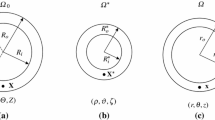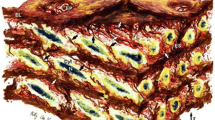Abstract
The selection of a mathematical descriptor for the passive arterial mechanical behavior has been long debated in the literature and customarily constrained by lack of pertinent data on the underlying microstructure. Our objective was to analyze the response of carotid artery subjected to inflation/extension with phenomenological and microstructure-based candidate strain-energy functions (SEFs), according to species (rabbit vs. pig) and region (proximal vs. distal). Histological variations among segments were examined, aiming to explicitly relate them with the differential material response. The Fung-type model could not capture the biphasic response alone. Combining a neo-Hookean with a two-fiber family term alleviated this restraint, but force data were poorly captured, while consideration of low-stress anisotropy via a quadratic term allowed improved simulation of both pressure and force data. The best fitting was achieved with the quadratic and Fung-type or four-fiber family SEF. The latter simulated more closely than the two-fiber family the high-stress response, being structurally justified for all artery types, whereas the quadratic term was justified for transitional and muscular arteries exhibiting notable elastin anisotropy. Diagonally arranged fibers were associated with pericellular medial collagen, and circumferentially and longitudinally arranged fibers with medial and adventitial collagen bundles, evidenced by the significant correlations of SEF parameters with quantitative histology.





Similar content being viewed by others
References
Baaijens F, Bouten C, Driessen N (2010) Modeling collagen remodeling. J Biomech 43:166–175
Chuong CJ, Fung YC (1986) On residual stresses in arteries. J Biomech Eng 108:189–191
Clark JM, Glagov S (1985) Transmural organization of the arterial media. The lamellar unit revisited. Arteriosclerosis 5:19–34
Cox RH (1978) Comparison of carotid artery mechanics in the rat, rabbit, and dog. Am J Physiol 234:H280–H288
Crissman RS (1986) SEM observations of the elastic networks in canine femoral artery. Am J Anat 175:481–492
Delfino A, Stergiopulos N, Moore JE et al (1997) Residual strain effects on the stress field in a thick wall finite element model of the human carotid bifurcation. J Biomech 18:777–786
Demiray H, Weizsäcker HW, Pascale K (1986) A mechanical model for passive behaviour of rats carotid artery. Biomed Tech (Berl) 31:46–52
Driessen NJ, Bouten CV, Baaijens FP (2005) A structural constitutive model for collagenous cardiovascular tissues incorporating the angular fiber distribution. J Biomech Eng 127:494–503
Finlay HM, McCullough L, Canham PB (1995) Three-dimensional collagen organization of human brain arteries at different transmural pressures. J Vasc Res 32:301–312
Fung YC (1993) Biomechanics: mechanical properties of living tissues. Springer, New York
Fung YC, Fronek K, Patitucci P (1979) Pseudoelasticity of arteries and the choice of its mathematical expression. Am J Physiol 237:H620–H631
Gleason RL, Dye WW, Wilson E et al (2008) Quantification of the mechanical behavior of carotid arteries from wild-type, dystrophin-deficient, and sarcoglycan-d knockout mice. J Biomech 41:3213–3218
Gosline JM (1980) The elastic properties of rubber-like proteins and highly extensible tissues. Cambridge University Press, Cambridge
Gundiah N, Ratcliffe MB, Pruitt LA (2007) Determination of strain energy function for arterial elastin: experiments using histology and mechanical tests. J Biomech 40:586–594
Hansen L, Wan W, Gleason RL (2009) Microstructurally motivated constitutive modeling of mouse arteries cultured under altered axial stretch. J Biomech Eng 131:101015
Holzapfel GA, Ogden RW (2010) Constitutive modelling of arteries. Proc R Soc A 466:1551–1597
Holzapfel GA, Weizsäcker HW (1998) Biomechanical behavior of the arterial wall and its numerical characterization. Comput Biol Med 28:377–392
Holzapfel GA, Gasser CT, Ogden RW (2000) A new constitutive framework for arterial wall mechanics and a comparative study of material models. J Elast 61:1–48
Humphrey JD (1995) Mechanics of the arterial wall: review and directions. Crit Rev Biomed Eng 23:1–162
Humphrey JD (1999) An evaluation of pseudoelastic descriptors used in arterial mechanics. J Biomech Eng 121:259–262
Lillie MA, Gosline JM (2007) Mechanical properties of elastin along the thoracic aorta in the pig. J Biomech 40:2214–2221
O’Connell MK, Murthy S, Phan S et al (2008) The three-dimensional micro- and nano-structure of the aortic medial lamellar unit measured using 3D confocal and electron microscopy imaging. Matrix Biol 27:171–181
Pandit A, Lu X, Wang C et al (2005) Biaxial elastic material properties of porcine coronary media and adventitia. Am J Physiol 288:H2581–H2587
Pasquali-Ronchetti I, Alessandrini A, Baccarani Contri M et al (1998) Study of elastic fiber organization by scanning force microscopy. Matrix Biol 17:75–83
Pianosi C, Burattini AR, Desch GW et al (1999) Biphasic stress-strain relationship of arteries: dependence on topography and animal species. Proceedings of the 1st European Medical and Biological Engineering Conference EMBEC’99, Vienna, Austria. Med Biol Eng Comput 37:1432–1433
Rezakhaniha R, Stergiopulos N (2008) A structural model of the venous wall considering elastin anisotropy. J Biomech Eng 130:031017
Rezakhaniha R, Fonck E, Genoud C, Stergiopulos N (2010) Role of elastin anisotropy in structural strain energy functions of arterial tissue. Biomech Model Mechanobiol. doi:10.1007/s10237-010-0259-x
Rhodin JAG (1980) Architecture of the vessel wall. In: Bohr DF, Somlyo AD, Sparks HV Jr (eds) Handbook of physiology, section 2: the cardiovascular system, vol ii: vascular smooth muscle. American Physiological Society, Bethesda, pp 1–31
Roach MR, Song SH (1988) Arterial elastin as seen with scanning electron microscopy: a review. Scan Microsc 2:994–1004
Sherebrin MH, Song SH, Roach MR (1982) Mechanical anisotropy of purified elastin from the thoracic aorta of dog and sheep. Can J Biochem Physiol 61:539–545
Sokolis DP (2008) Passive mechanical properties and constitutive modeling of blood vessels in relation to microstructure. Med Biol Eng Comput 46:1187–1199
Sokolis DP (2010) A passive strain-energy function for elastic and muscular arteries: correlation of material parameters with histological data. Med Biol Eng Comput 48:507–518
Sokolis DP, Kefaloyannis EM, Kouloukoussa M et al (2006) A structural basis for the aortic stress-strain relation in uniaxial tension. J Biomech 39:1651–1662
Sommer G, Regitnig P, Költringer L, Holzapfel GA (2010) Biaxial mechanical properties of intact and layer-dissected human carotid arteries at physiological and supraphysiological loadings. Am J Physiol Heart Circ Physiol 298:H898–H912
Stavropoulou E, Dafalias YF, Sokolis DP (2009) Biomechanical and histological characteristics of passive esophagus: Experimental investigation and comparative constitutive modeling. J Biomech 42:2654–2663
Takamizawa K, Hayashi K (1987) Strain energy density function and uniform strain hypothesis for arterial mechanics. J Biomech 20:7–17
Takamizawa K, Hayashi K (1988) Uniform strain hypothesis and thin-walled theory in arterial mechanics. Biorheology 25:555–565
Tong P, Fung YC (1976) The stress–strain relationship for skin. J Biomech 9:649–657
Vito RP, Dixon SA (2003) Blood vessel constitutive models—1995–2002. Ann Rev Biomed Eng 5:413–439
von Maltzahn WW, Warriyar RG, Keitzer WF (1984) Experimental measurements of elastic properties of media and adventitia of bovine carotid arteries. J Biomech 17:839–847
Watton PN, Ventikos Y, Holzapfel GA (2009) Modelling the mechanical response of elastin for arterial tissue. J Biomech 42:1320–1325
Weizsäcker HW, Holzapfel GA, Desch GW et al (1995) Strain energy density function for arteries from different topographical sites. Biomed Tech (Berl) 2:139–141
Wicker BK, Hutchens HP, Wu Q, Yeh AT, Humphrey JD (2008) Normal basilar artery structure and biaxial mechanical behavior. Comput Methods Biomech Biomed Eng 11:539–551
Zhou J, Fung YC (1996) The degree of nonlinearity and anisotropy of blood vessel elasticity. Proc Natl Acad Sci USA 94:14255–14260
Zou Y, Zhang Y (2009) An experimental and theoretical study on the anisotropy of elastin network. Ann Biomed Eng 37:1572–1583
Zulliger MA, Fridez P, Hayashi K et al (2004) A strain energy function for arteries accounting for wall composition and structure. J Biomech 37:989–1000
Author information
Authors and Affiliations
Corresponding author
Rights and permissions
About this article
Cite this article
Sokolis, D.P., Sassani, S., Kritharis, E.P. et al. Differential histomechanical response of carotid artery in relation to species and region: mathematical description accounting for elastin and collagen anisotropy. Med Biol Eng Comput 49, 867–879 (2011). https://doi.org/10.1007/s11517-011-0784-5
Received:
Accepted:
Published:
Issue Date:
DOI: https://doi.org/10.1007/s11517-011-0784-5




